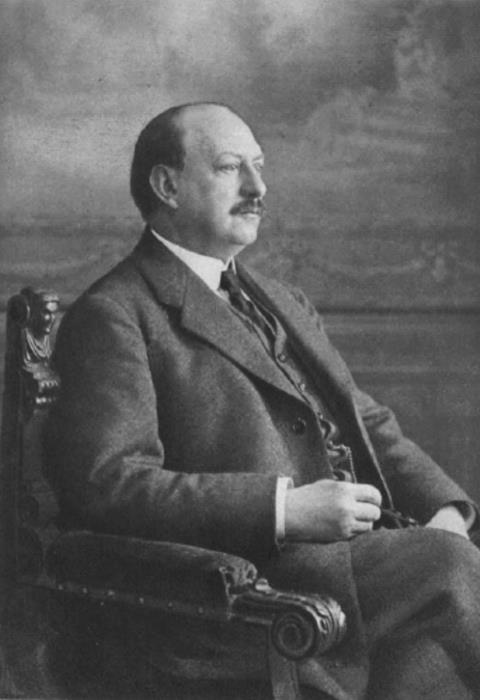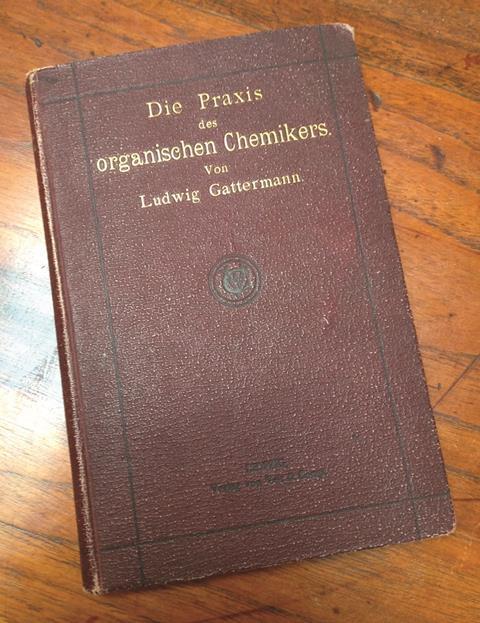The story of the man whose chemistry textbook saved Primo Levi’s life
Ludwig Gattermann
German chemist (1860–1920). Author of The organic chemist’s practicum

About a year ago, the human rights lawyer Philippe Sands organised a remarkable event in the Royal Festival Hall in London: a complete reading of Primo Levi’s If this is a man, a memoir of Levi’s imprisonment at the Nazi extermination camp at Auschwitz. The readers included actors, playwrights, novelists and jurists as well as several genocide survivors. In the 10th chapter, The chemistry exam, read that afternoon by the chemist Martyn Poliakoff, Levi is summoned to an office outside the fence of the camp to be quizzed about chemistry by the director of the Buna rubber factory. Levi’s sense of unreality is heightened when he is handed a copy of Ludwig Gattermann’s Die Praxis der organischen Chemikers (The organic chemist’s practicum) identical to the one he had owned and worked from as a chemistry undergraduate in Turin before the war. Not surprisingly, he is chosen to be assistant in a lab, where he comes into contact with German civilians from the nearby town. To them he is next to invisible; in turn, he observes them with a mix of curiosity and horror.
After the performance, I hurried home and pulled down my own copy of Die Praxis der organischen Chemikers. A maroon quarto with a textured, soft cover, it describes chemical techniques and procedures in simple, spare language that even my rudimentary German could cope with. As I flipped the pages, it occurred to me that against all the odds, Gattermann’s book had perhaps helped save Levi’s life. But who was this Gattermann?
Ludwig Gattermann was a baker’s son born in the foothills of the Harz mountains in Lower Saxony, Germany. As a child he delighted in collecting butterflies and minerals, and while still at school he started doing chemical experiments at home. He spent part of his military service at the University of Leipzig, but then moved to Heidelberg where he spent a year with Robert Bunsen. Wanting to focus on organic chemistry, Gattermann then went to Berlin to work with one of Bunsen’s former students, the synthetic organic chemist Carl Liebermann (discoverer of the dye alizarin). One of Liebermann’s assistants remarked that Gattermann already had an exceptional laboratory instinct and superb synthetic skills.
Ludwig Gattermann was a baker’s son born in the foothills of the Harz mountains in Lower Saxony, Germany. As a child he delighted in collecting butterflies and minerals, and while still at school he started doing chemical experiments at home. He spent part of his military service at the University of Leipzig, but then moved to Heidelberg where he spent a year with Robert Bunsen (Chemistry World, October 2007, p77). Wanting to focus on organic chemistry, Gattermann then went to Berlin to work with one of Bunsen’s former students, the synthetic organic chemist Carl Liebermann (discoverer of the dye alizarin). One of Liebermann’s assistants remarked that Gattermann already had an exceptional laboratory instinct and superb synthetic skills.
After less than a semester, Gattermann left for Göttingen to work with another organic chemist, Hans Hübner. Here, he quickly developed a reputation as someone who could build kit and improve methods, from furnaces to nitrogen analysis. Within a few months, Gattermann was Hübner’s trusted lecture demonstrator; Gattermann gained exposure to a wide range of chemistry while also working towards his dissertation on aromatic chemistry. Hübner’s sudden death in 1885 left Gattermann without a supervisor.
Viktor Meyer’s arrival from Zürich was a turning point for both Gattermann and for Göttingen. Meyer’s charisma attracted students in droves and the department flourished. Although Meyer had brought some of his assistants with him, Gattermann was in a different league of efficiency and skill. He was soon Meyer’s right hand man. In return, Meyer ensured Gattermann had enough time and space to do his own research.
Viktor Meyer’s (Chemistry World, February 2012, p60) arrival from Zürich was a turning point for both Gattermann and for Göttingen. Meyer’s charisma attracted students in droves and the department flourished. Although Meyer had brought some of his assistants with him, Gattermann was in a different league of efficiency and skill. He was soon Meyer’s right hand man. In return, Meyer ensured Gattermann had enough time and space to do his own research.
It was a very happy and productive time for Gattermann, who was gregarious and the centre of a lunchtime club that included not only chemists but law and classics dons too. A 1907 paper gives an idea of his approach in the lab: he recommends that students smoke a cigar when working with hydrogen cyanide as even trace quantities give an ‘undefinable but very characteristic taste to the smoke’.

Gattermann’s research was highly varied, including syntheses of carboxylic acids using carbamoyl chloride, as well as developing Friedel–Crafts alkylation, especially with Meyer’s discovery, thiophene. But Gattermann really made his name by his attempt to purify and properly analyse the terrifyingly unstable chloride of nitrogen, whose stoichiometry was still uncertain. In spite of numerous explosions, Gattermann succeeded in preparing an exceptionally pure sample, confirming that ‘nitrogen perchloride’ had the formula NCl3. A British newspaper that picked up the story described him as a ‘hero of science’, a phrase that led to endless ribbing from his colleagues.
In 1889, Bunsen retired and Meyer was appointed to succeed him. Gattermann moved back to Heidelberg with him. By this time he was known as an enthusiastic and cheerful teacher of students in the laboratory. He decided to commit what he knew to a book ‘to draw every single student’s attention to the many little tricks which are required in organic synthesis’.
Gattermann wrote a simple and direct account of the basic techniques – filtration, reflux, distillation – that every student must master, followed by some sixty syntheses and analyses to put these methods in practice. Published in 1894, Gattermann’s volume became known as his ‘cookbook’, a term used sniffily by some senior chemists who thought it intellectually inferior. It was adopted cheerfully by the self-deprecating Gattermann himself who, forever the baker’s son, had never felt comfortable around posh professors anyway. For all the condescension, Gattermann’s ‘cookbook’ was a spectacular success; it would be reprinted even long after his death in 1920. A couple of retired colleagues, trained in the 1940s and 1950s, told me they used the book as students.
If today it is hard to countenance any chemistry text saving anyone’s life, Primo Levi’s are books for our time, especially The periodic table. An extraordinary meditation on man’s inhumanity to man and how it might be possible to rise above it, it has never seemed more relevant than today as memories of the horrors of the second world war fade. Read it. Share it. And then read it again.
Acknowledgments
I am grateful to Philippe Sands, Alwyn Davies, Mike Porter, Thomas Morris and Peter Garratt
References
L Gattermann, Die Praxis der organischen Chemikers, Leipzig: Verlag von Veit & Co., 1894.












No comments yet